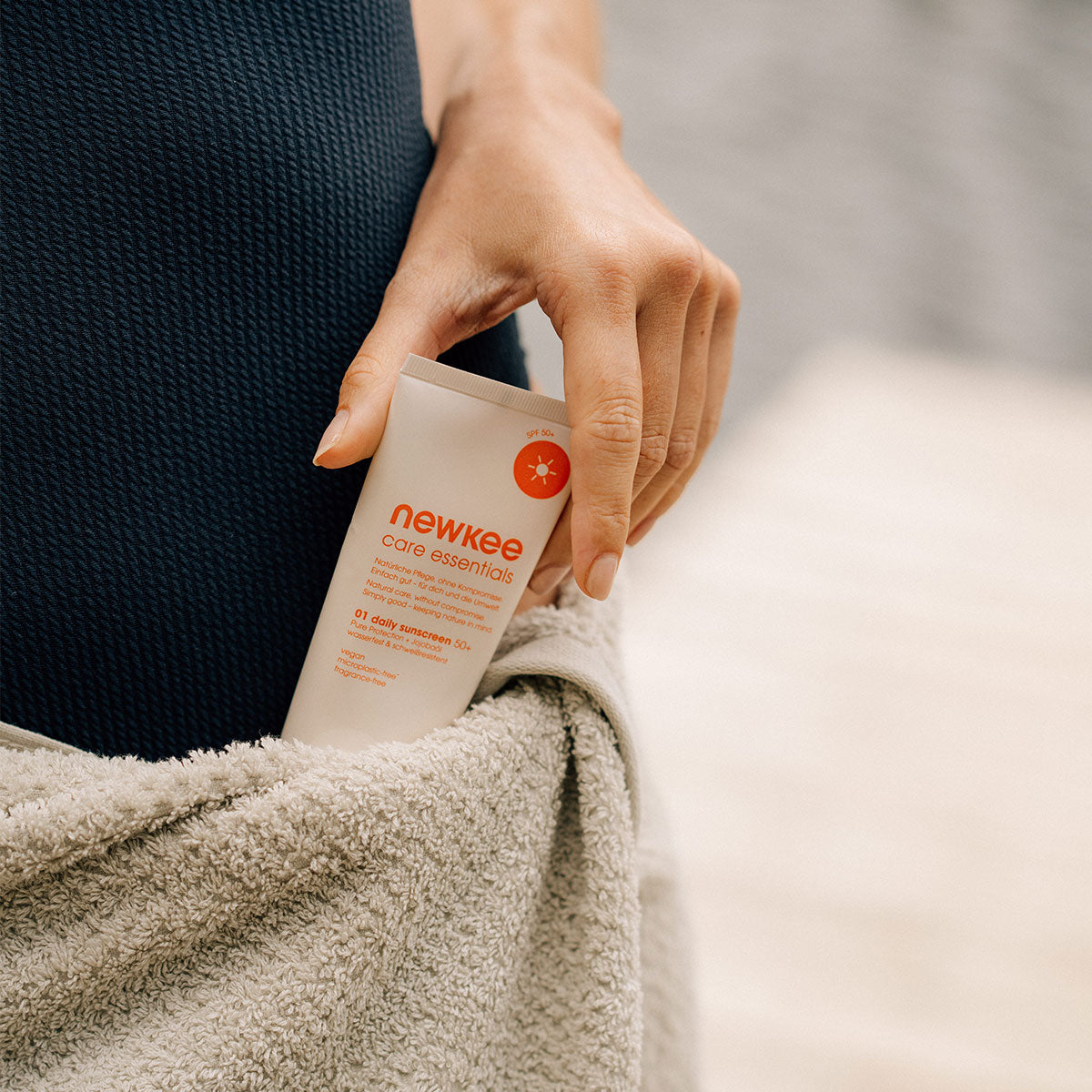
Why clouds can't protect you from the sun
Clouds are gathering outside, the sky is completely overcast—then you don't need sunscreen, right? Unfortunately, it's not that simple. Even when the sun hides from us, its invisible UV rays can penetrate the clouds and damage your skin. We'll show you exactly what happens when UV rays hit a cloud cover, and why it's important to use sunscreen even when the sky is cloudy.
Do clouds protect us from UV rays?
The idea that clouds act as a natural barrier against UV radiation is not fundamentally wrong. Clouds can indeed block some of the sun's rays – depending on their density and their height and shape in the sky.
A dense cloud cover can block more UV rays than a thin, high-flying cloud. However, this only applies to a portion of the rays. Complete UV protection from clouds is not possible.
The interaction between water vapor and cloud particles (both cloud droplets and ice crystals) is crucial for the formation of clouds as well as for weather phenomena such as rain, snow, hail and other precipitation.
When in contact with UV rays, these cloud particles can absorb, reflect and scatter the radiation – depending on the density, size and composition of the clouds.
This happens when UV rays hit clouds
When UV radiation (as well as visible light and other types of radiation) hits clouds, several things can happen:
Absorption: Part of the UV radiation can be absorbed by cloud droplets. This means that the radiation is "absorbed" by the cloud particles and converted into another form of energy, often heat.
Reflection: Some rays are reflected off the surface of cloud droplets, similar to sunlight reflected from a mirror. This can cause the radiation to be scattered back into space or in other directions.
Scattering: Much of the UV radiation is scattered within the cloud. This means that it is deflected in many different directions after interacting with cloud particles. This process can reduce or, in some cases, even increase the intensity of UV rays reaching the ground, depending on the type and composition of the clouds.
These cloud shapes amplify UV rays
In fact, there are cloud formations and conditions that can influence the intensity of UV radiation and, in some cases, even increase it:
Thin clouds: Thin clouds, or clouds that are just forming or dissipating, can act as a scattering agent for UV radiation. They scatter radiation and, at certain angles, can cause an increase in UV intensity at the Earth's surface.
Gaps and edges of clouds: UV radiation can be more intense at the edges of clouds or through gaps in cloud cover. This phenomenon is also known as "lensing." This can result in brief periods of intense sunlight, raising the risk of sunburn even when the sky appears cloudy overall.
In addition to cloud shape and properties, the actual UV intensity is influenced by other factors, including your latitude, altitude above sea level, the season and time of day, and other atmospheric conditions.
To best protect yourself from UV rays, you don't need to inform yourself about all of these factors every day – a simple look at the UV index is enough!
Your compass for sun protection: The UV index
The UV index is an important tool for assessing your daily UV risk. It indicates the respective radiation exposure in individual levels from 0 to 11+. Even at values between 3 and 5, you should reach for your sunscreen . If the values rise even further, you should further protect yourself from the sun with a hat, sunglasses, and, if necessary, long, airy clothing.
UV index – what the individual levels mean
The UV Index (UVI) is an international scale measuring the intensity of ultraviolet radiation in relation to its potential danger to our skin. It was developed by the World Health Organization (WHO) and is intended to give us a better understanding of UV risks and help us choose the right sun protection.
The UV index scale typically ranges from 0 to 11+:
0-2 (Low): There is only a low risk from unprotected sun exposure. However, you should always consider whether light protection is necessary.
3-5 (Moderate): There is a moderate risk. Protective measures are recommended, especially for people with fair skin. Sunglasses, sunscreen, and a hat are advisable.
6-7 (High): A high risk of damage from unprotected sun exposure. Protective measures are important: Avoid the sun between 10 a.m. and 4 p.m., wear sunscreen, a hat, sunglasses, and protective clothing.
8-10 (Very high): A very high risk. If possible, you should avoid the sun completely or protect yourself from sun exposure at these values.
11+ (Extremely High): This value indicates an extremely high risk of damage from sun exposure. All protective measures should be strictly followed. Complete avoidance of the sun during the hottest hours of the day is recommended.
NOTE: A high UV index doesn't automatically mean it's sunny; even on cloudy days, the UV index can be high. Therefore, simply glancing out the window isn't enough. Only the UV index can reliably tell you whether you need sun protection or not!
It's so easy to check the UV index
You can easily check the current UV index using your smartphone. Generally, all common weather apps offer up-to-date data for your location. Online weather portals are also a reliable source. During the summer months, radio stations and news programs also regularly provide information about the UV index.

Conclusion
Don't be fooled by clouds – even on gray days, UV radiation can be intense enough to damage your skin and cause sunburn. To assess your risk of skin damage, check your UV index daily and protect yourself from the sun based on the index value. On days with a low index up to level 3, a light SPF 15 is sufficient, which you can find in our face cream day with SPF 15 , for example. On days with a higher value , we generally recommend SPF 50+ . With it, you're always on the safe side – whether the sky is clear or full of gray clouds.

